Nickel allergy from kitchen appliances: What you need to know
02/17/2021 Food Intolerances Natural food guide
A nickel allergy is primarily caused by objects containing nickel, such as jewelry, buttons, or doorknobs, coming into direct contact with the skin. In severe cases, however, symptoms can also develop through an excess of nickel in your diet.
Many common kitchen utensils contain nickel, and the potential danger they pose to consumers is an important question to consider, both for allergy sufferers and those without an allergy to nickel. We have analyzed the effects of three types of kitchen utensils on your exposure to nickel: cookware (pots and pans), kettles, and taps.
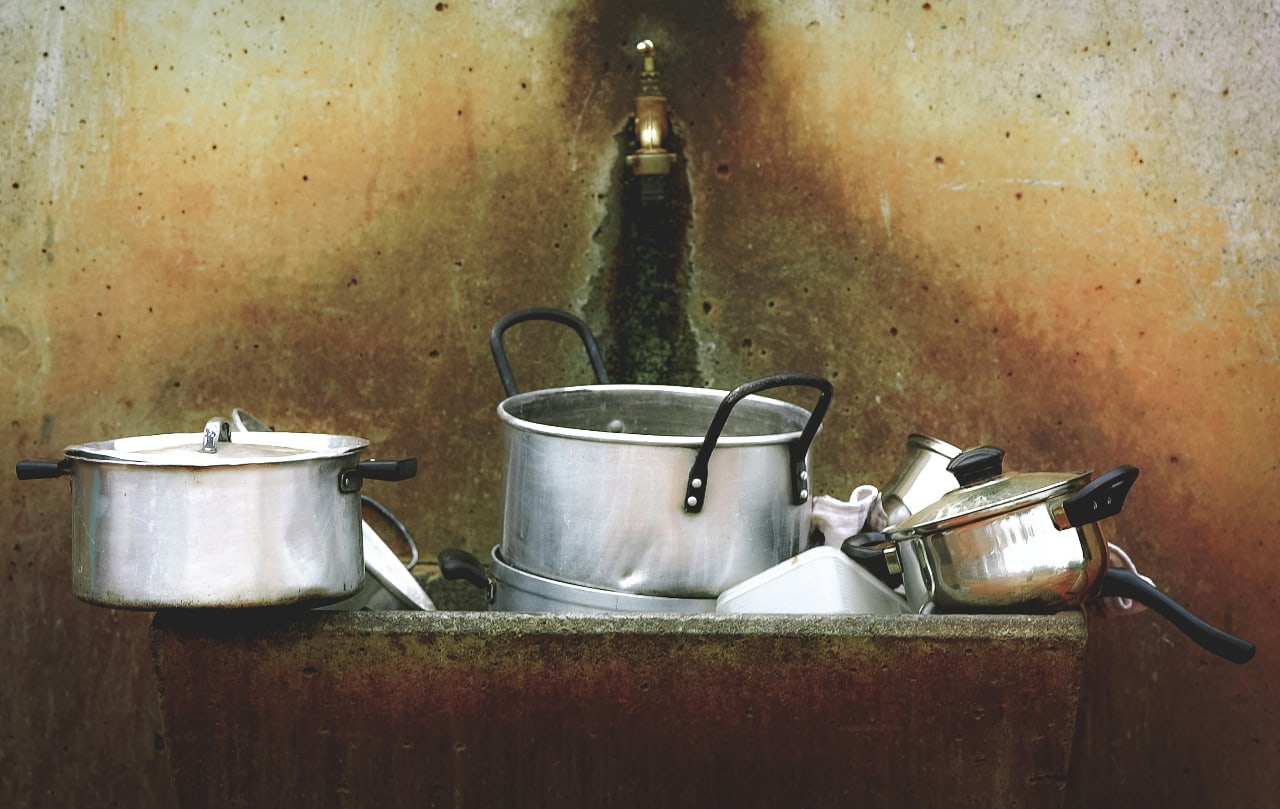
Cooking pots and pans can be made from a vast array of materials. The widely used stainless steel varieties contain the largest concentration of nickel, while levels of nickel content are comparatively low in most other cookware materials (see Table 1).
▲ Table 1: Nickel content and market share of the most popular cookware
The stainless steel used in cookware sets is an alloy of iron, chrome, and nickel. You can determine the content of these separate elements by consulting the steel grade on the bottom of your pot or pan: 18/10 stainless steel contains 18% chrome and 10% nickel, while iron makes up the remainder. The nickel present makes the alloy more malleable and corrosion-resistant, and produces a smooth, shiny finish. 18/10 stainless steel (also known as type 304) is therefore the most popular type of cookware currently available on the market, accounting for four of every five pots or pans purchased over the counter. Nickel-free 18/0 stainless steel, meanwhile, has yet to make a strong impression with consumers.
There are multiple studies that deal with the release of nickel from cooking equipment, and from their results we can trace one common theme: albeit in relatively low amounts, nickel is released in the cooking process when using stainless steel pots and pans. According to a study by Flint (1997), the nickel released by stainless steel pots and pans into various foods (e.g. potatoes or a fruit compote) amounts to between 0–64 μg/kg. This may seem like a high number, but when measured against the portion size of food actually consumed, the result is a comparatively meagre 0–10 μg. Nevertheless, there are some outlying cases where an increased amount of nickel release can be traced.
Cooking with brand new cookware
The many studies on this topic have noted that a higher amount of nickel – up to 200 μg/l – is released when using brand new cookware, although this falls to a low level after a few uses. The reason behind this increase could lie in the manufacturing process. Polishing a stainless steel pan can leave behind a fine residue of oxidized steel chips, which can lead to a higher concentration of nickel being released from the pot or pan during the first few uses. However, after these initial uses, this effect is noticeably lessened.
Cooking foods with acidic pH values
Organic acids, high quantities of which can be found in many fruits and vegetables, have a corrosive effect on pots and pans as atoms of iron, chrome, and nickel are released from the metal during cooking. For example, cooking tomato sauce or a vegetable compote in a stainless steel pot will result in a higher release of nickel compared to potatoes or pasta, which have a more neutral pH value. For this reason it is recommended to cook acidic foods in another type of pot, such as Teflon.
There will always be a certain additional amount of nickel present in our food when using stainless steel pots and pans. An especially common form of this is through nickel ions, present on the inside of a pot or pan, that are released by acids in food during the cooking process. Nevertheless, the exposure to nickel from cookware is markedly lower than that which we simply ingest through food itself. A large amount of the nickel released when boiling potatoes or pasta, for example, is often removed simply by draining the water. And since the actual amount consumed per portion is relatively low, there is little evidence to suggest we should avoid using stainless steel pots altogether. Moreover, if the contents of the pot are just warmed up and not boiled for longer periods, the amount of nickel released is negligible.
The quantities of nickel to which non-allergy sufferers, and indeed even most allergy sufferers, are exposed is often harmless. Yet it is nevertheless important to prevent a sensitization to the substance, and likely an increase in the number of allergy sufferers, among the general population. So it is therefore desirable that as little nickel as possible ends up in our food. Nickel-free stainless steel has not yet emerged as a popular consumer product, despite the technology certainly being available to develop it. In the meantime, however, there is a plethora of alternatives, completely free of nickel, that can minimize our nickel intake (see Table 1).
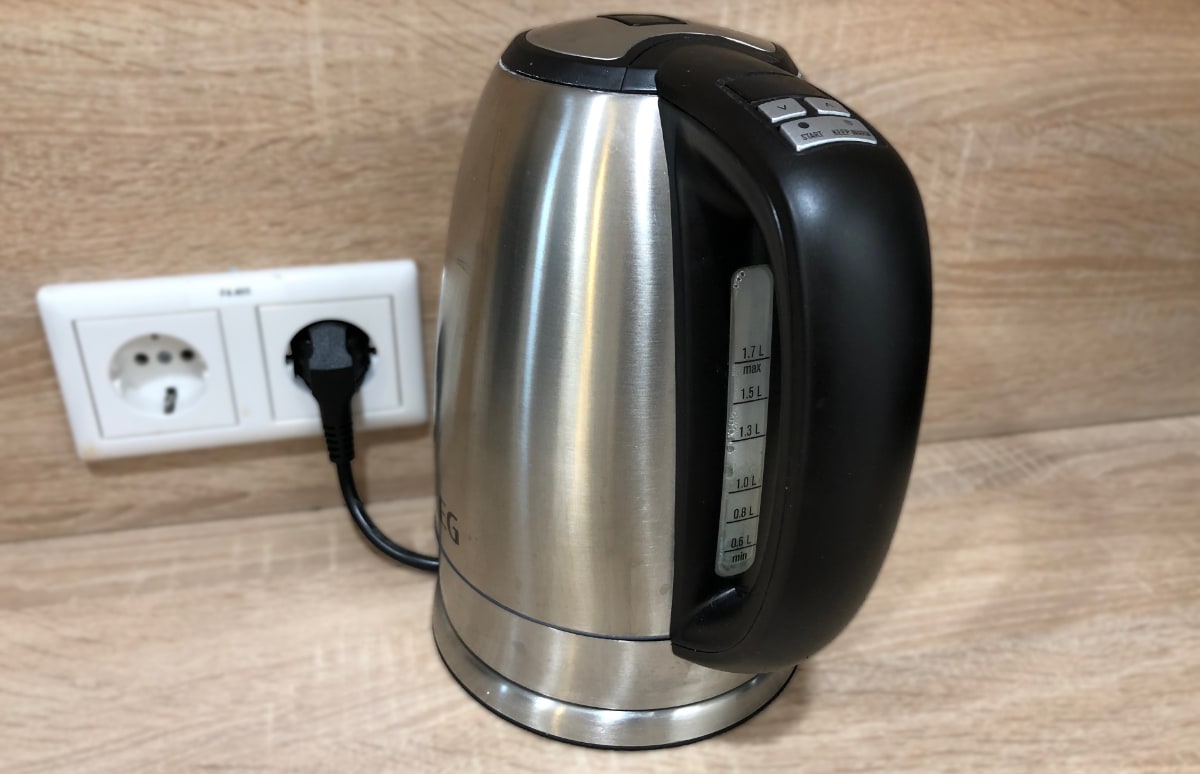
Kettles also contain materials in which nickel can be found, some of which is released when boiling water. In general there are two types of appliances we need to differentiate between here: kettles with a heated base plate, made of stainless steel, as well as a water tank made of stainless steel, plastic, or glass; and kettles with an exposed heating coil or filament (these are often found in cheaper models).
The exposed coil releases significantly more nickel into the water than a stainless steel base plate, since the filament is usually coated in nickel (see Table 2).
▲ Table 2: Nickel released by various kettle heating elements
Consumers should take note that newer kettle models release the highest levels of nickel, and the amount can occasionally be critical. It is also vital to remember that if kettles are regularly de-scaled with vinegar, the aggressive effect of the acids in vinegar drastically increases the levels of nickel released when the kettle is subsequently used. Only after roughly 6–10 uses does the nickel level return to a relatively low amount. For this reason, it is recommended to de-scale your kettle as infrequently as possible, ensuring that directly afterwards, fresh water is boiled and then discarded before you resume use.
Water that has been boiled and left in a kettle for an extended period of time will result in increased amounts of nickel as time passes. Again, it is therefore recommended to pour stale water away and re-fill your kettle.
Nickel found in kettles also has a high bio-availability, especially, for example, if you drink a cup of tea on an empty stomach. Instead, have that cup of tea with a proper breakfast, since eating significantly hinders the absorption of nickel into your body.
When buying a nickel-free kettle, make absolutely sure that it is made of 100% glass or 18/0 stainless steel. Even kettles with a container made of glass almost exclusively use a base plate of stainless steel in which nickel will be present. Unfortunately, you can find more than a few unscrupulous manufacturers intent on giving you wrong information and charging you a hefty price for an apparently nickel-free kettle. Remember that completely nickel-free kettles are currently not widely available.
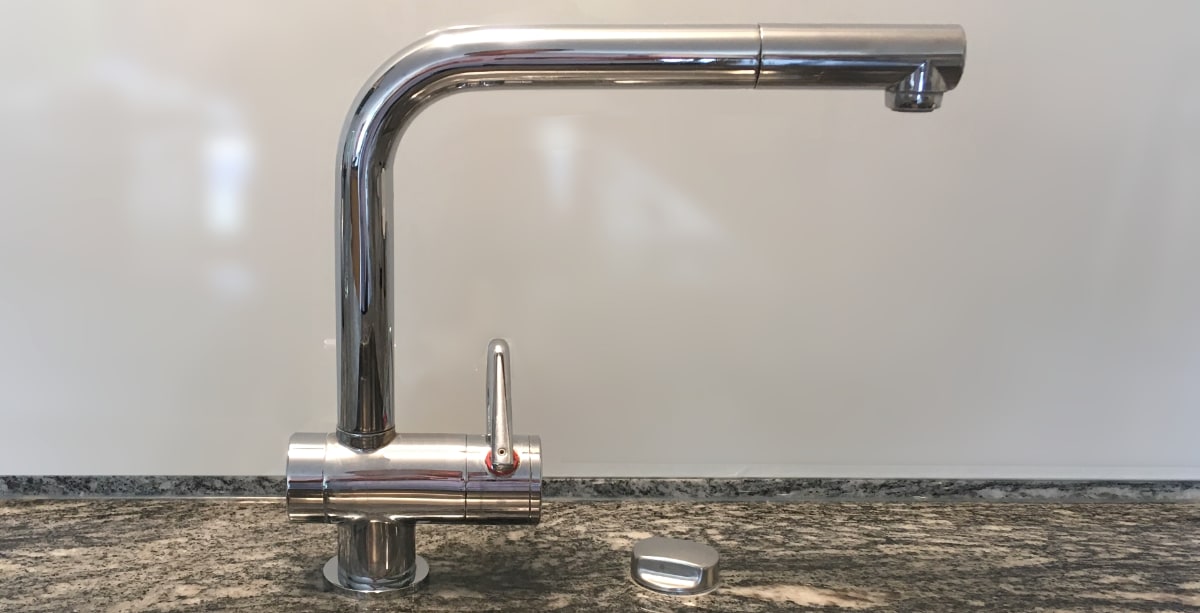
Chrome-plated tap fittings can also result in the release of nickel into water, and in Germany, the National Environment Agency has moved to regulate this by mandating that after three months following their installation, faucets may release a maximum of 20 μg/l into water. If hot water remains in a tap for an extended period of time (e.g. overnight), this limit can easily be exceeded. So it is a good idea to let your tap run for a few seconds to rinse away leftover water. As an alternative, you can also use bottled drinking water, which generally contains very little nickel.
Several household appliances have the potential to release nickel into your food (see Figure 1).
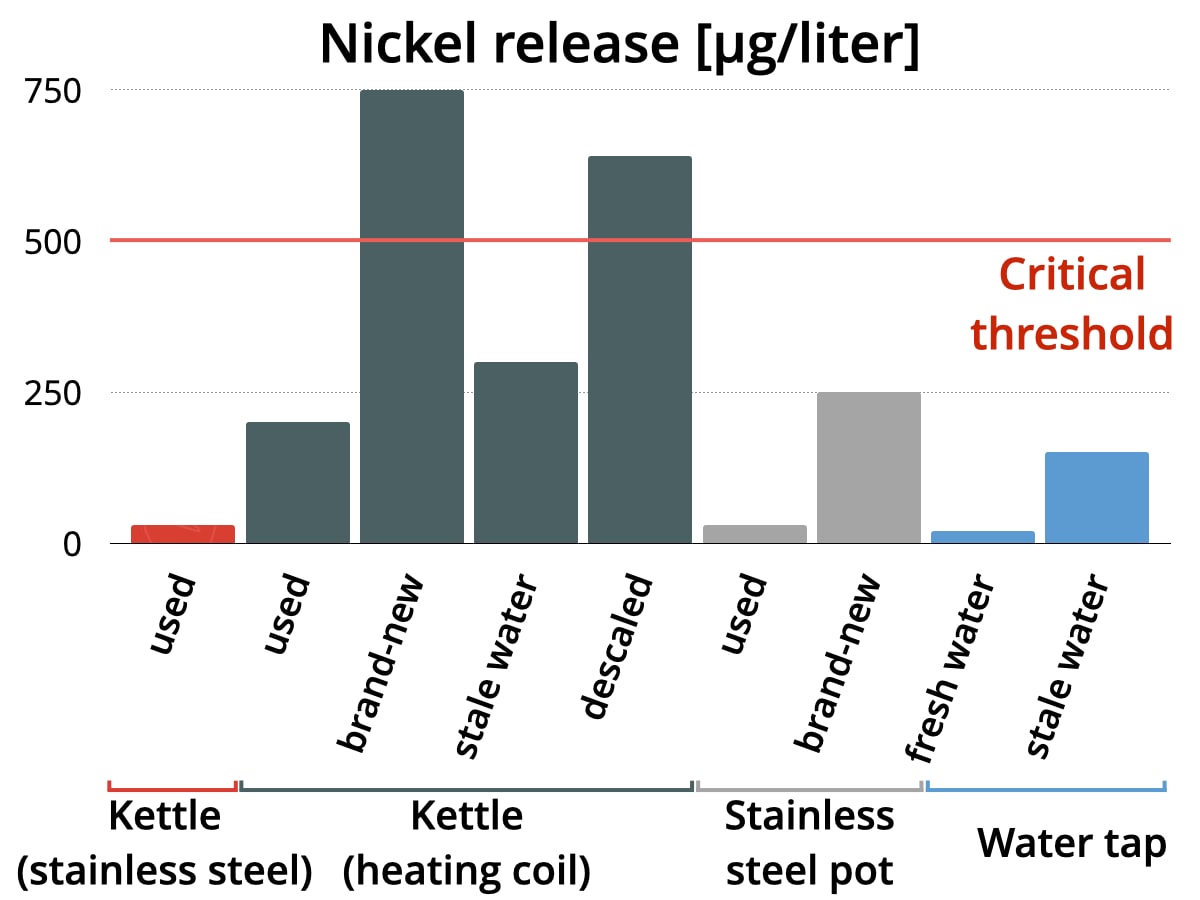
▲ Figure 1: Nickel released from various household appliances
Here are two scenarios that better illustrate the proportion of your daily nickel intake through household substances containing nickel (see Figure 2).
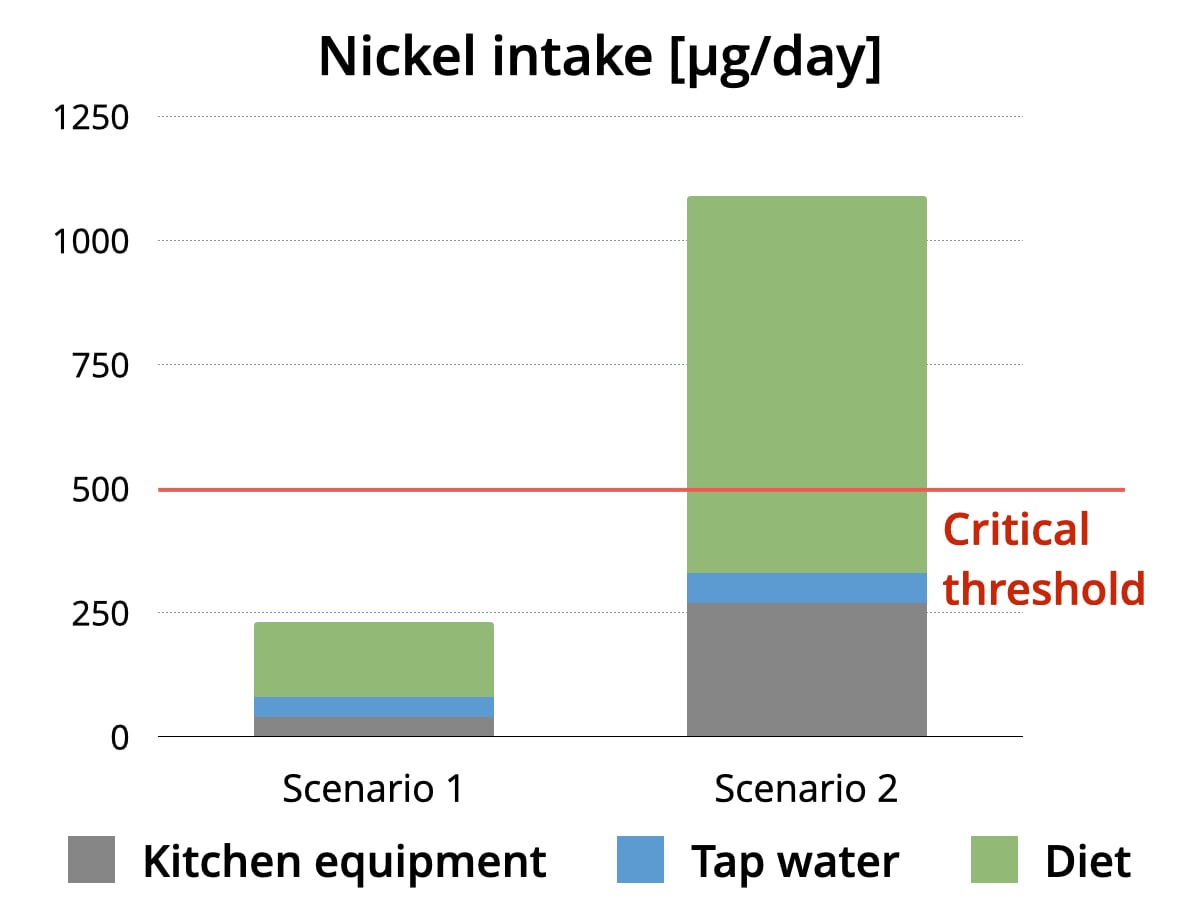
▲ Figure 2: Scenario 1 illustrates a low nickel diet and recommended use of kitchen appliances containing nickel. Scenario 2 illustrates a high nickel diet and unrecommended use of kitchen appliances containing nickel, e.g. stale tap water, using a recently de-scaled kettle with an exposed heating filament, new stainless steel pots and pans.
Even disregarding all the precautionary measures outlined above, it is only in exceptional cases that a person will exceed the daily limit of 500 μg of nickel per day, which is considered critical. A naturally high nickel diet can also be a contributing factor here, and for some allergy sufferers the excess nickel consumption can lead to a flare-up of symptoms, despite it not coming into direct contact with the skin (which, as we noted above, is the primary cause of a nickel allergy).
However, following a few simple rules, without the need for undue restrictions on your daily life, will ensure that nickel exposure from kitchen appliances has little effect on your daily intake. And when it comes to buying a new kitchen appliance, consider the best-priced product, instead of overpaying for a “specialized” item.
Back to blog
References:
G. Flint et al., Purity of food cooked in stainless steel utensils, Food Additives & Contaminants 14:2 (1997), 115–126
H. Lampel et al., Systemic Contact Dermatitis: Current Challenges and Emerging Treatments, Current Treatment Options in Allergy 1 (2014), 348–357
T. Berg et al., The release of nickel and other trace elements from electric kettles and coffee machines, Food Additives and Contaminants 17:3 (2000), 189–196
test 08/2006, Heiße Ware, 64–69
J. Kuligowski et al., Stainless Steel Cookware as a significant Source of Nickel, Chromium, and Iron, Arch. Environ. Contam. Toxicol. 23 (1992), 211–215
M. Tuchman et al., Nickel contact dermatitis in children, Clinics in Dermatology 33 (2015), 320–326
https://www.lgl.bayern.de/produkte/bedarfsgegenstaende/bg_lebensmittelkontakt/ue_2012_wasserkocher_nickel.htm (Abgerufen Juli 2019)
T. Rapp et al., Nickelüberzüge von Produkten in Kontakt mit Trinkwasser, Wasser-Praxis 02/2010, 16–17
Bekanntmachung des Umweltbundesamtes, Nickel, Bundesgesundhbl – Gesundheitsforsch – Gesundheitsschutz 44 (2001) 12, 1243-1248
Image:
Foto by Scott Umstattd on Unsplash
Many common kitchen utensils contain nickel, and the potential danger they pose to consumers is an important question to consider, both for allergy sufferers and those without an allergy to nickel. We have analyzed the effects of three types of kitchen utensils on your exposure to nickel: cookware (pots and pans), kettles, and taps.

Which cookware is nickel-free?
Cooking pots and pans can be made from a vast array of materials. The widely used stainless steel varieties contain the largest concentration of nickel, while levels of nickel content are comparatively low in most other cookware materials (see Table 1).
| Material | Nickel | Market share |
|---|---|---|
| Stainless steel (18/10) | 10 % | 80 % |
| Aluminium (Teflon coated) | 0 % | 16 % |
| Steel (enamel coated) | <1 % | 3 % |
| Cast iron | 0,1–1 % | <1 % |
| Ceramics | 0 % | <1 % |
| Steel (unalloyed) | 0 % | <1 % |
| Aluminium | 0 % | <1 % |
| Copper (tin coated) | 0 % | <1 % |
| Brass | 0 % | <1 % |
| Glass | 0 % | <1 % |
| Stainless steel (18/0) | 0,1–0,75 % | <1 % |
The stainless steel used in cookware sets is an alloy of iron, chrome, and nickel. You can determine the content of these separate elements by consulting the steel grade on the bottom of your pot or pan: 18/10 stainless steel contains 18% chrome and 10% nickel, while iron makes up the remainder. The nickel present makes the alloy more malleable and corrosion-resistant, and produces a smooth, shiny finish. 18/10 stainless steel (also known as type 304) is therefore the most popular type of cookware currently available on the market, accounting for four of every five pots or pans purchased over the counter. Nickel-free 18/0 stainless steel, meanwhile, has yet to make a strong impression with consumers.
When does your cookware release nickel?
There are multiple studies that deal with the release of nickel from cooking equipment, and from their results we can trace one common theme: albeit in relatively low amounts, nickel is released in the cooking process when using stainless steel pots and pans. According to a study by Flint (1997), the nickel released by stainless steel pots and pans into various foods (e.g. potatoes or a fruit compote) amounts to between 0–64 μg/kg. This may seem like a high number, but when measured against the portion size of food actually consumed, the result is a comparatively meagre 0–10 μg. Nevertheless, there are some outlying cases where an increased amount of nickel release can be traced.
Cooking with brand new cookware
The many studies on this topic have noted that a higher amount of nickel – up to 200 μg/l – is released when using brand new cookware, although this falls to a low level after a few uses. The reason behind this increase could lie in the manufacturing process. Polishing a stainless steel pan can leave behind a fine residue of oxidized steel chips, which can lead to a higher concentration of nickel being released from the pot or pan during the first few uses. However, after these initial uses, this effect is noticeably lessened.
Cooking foods with acidic pH values
Organic acids, high quantities of which can be found in many fruits and vegetables, have a corrosive effect on pots and pans as atoms of iron, chrome, and nickel are released from the metal during cooking. For example, cooking tomato sauce or a vegetable compote in a stainless steel pot will result in a higher release of nickel compared to potatoes or pasta, which have a more neutral pH value. For this reason it is recommended to cook acidic foods in another type of pot, such as Teflon.
Should I throw my stainless steel cookware away if I am allergic to nickel?
There will always be a certain additional amount of nickel present in our food when using stainless steel pots and pans. An especially common form of this is through nickel ions, present on the inside of a pot or pan, that are released by acids in food during the cooking process. Nevertheless, the exposure to nickel from cookware is markedly lower than that which we simply ingest through food itself. A large amount of the nickel released when boiling potatoes or pasta, for example, is often removed simply by draining the water. And since the actual amount consumed per portion is relatively low, there is little evidence to suggest we should avoid using stainless steel pots altogether. Moreover, if the contents of the pot are just warmed up and not boiled for longer periods, the amount of nickel released is negligible.
The quantities of nickel to which non-allergy sufferers, and indeed even most allergy sufferers, are exposed is often harmless. Yet it is nevertheless important to prevent a sensitization to the substance, and likely an increase in the number of allergy sufferers, among the general population. So it is therefore desirable that as little nickel as possible ends up in our food. Nickel-free stainless steel has not yet emerged as a popular consumer product, despite the technology certainly being available to develop it. In the meantime, however, there is a plethora of alternatives, completely free of nickel, that can minimize our nickel intake (see Table 1).
Kettles and nickel allergy

Kettles also contain materials in which nickel can be found, some of which is released when boiling water. In general there are two types of appliances we need to differentiate between here: kettles with a heated base plate, made of stainless steel, as well as a water tank made of stainless steel, plastic, or glass; and kettles with an exposed heating coil or filament (these are often found in cheaper models).
The exposed coil releases significantly more nickel into the water than a stainless steel base plate, since the filament is usually coated in nickel (see Table 2).
| Heating element | Nickel released into water [μg/l] |
|---|---|
| Nickel coated coil | 10–500 |
| Stainless steel plate | 0–30 |
| Aluminium with Teflon coating | 0 |
Consumers should take note that newer kettle models release the highest levels of nickel, and the amount can occasionally be critical. It is also vital to remember that if kettles are regularly de-scaled with vinegar, the aggressive effect of the acids in vinegar drastically increases the levels of nickel released when the kettle is subsequently used. Only after roughly 6–10 uses does the nickel level return to a relatively low amount. For this reason, it is recommended to de-scale your kettle as infrequently as possible, ensuring that directly afterwards, fresh water is boiled and then discarded before you resume use.
Water that has been boiled and left in a kettle for an extended period of time will result in increased amounts of nickel as time passes. Again, it is therefore recommended to pour stale water away and re-fill your kettle.
Nickel found in kettles also has a high bio-availability, especially, for example, if you drink a cup of tea on an empty stomach. Instead, have that cup of tea with a proper breakfast, since eating significantly hinders the absorption of nickel into your body.
Do your research when buying a nickel-free kettle!
When buying a nickel-free kettle, make absolutely sure that it is made of 100% glass or 18/0 stainless steel. Even kettles with a container made of glass almost exclusively use a base plate of stainless steel in which nickel will be present. Unfortunately, you can find more than a few unscrupulous manufacturers intent on giving you wrong information and charging you a hefty price for an apparently nickel-free kettle. Remember that completely nickel-free kettles are currently not widely available.
Taps

Chrome-plated tap fittings can also result in the release of nickel into water, and in Germany, the National Environment Agency has moved to regulate this by mandating that after three months following their installation, faucets may release a maximum of 20 μg/l into water. If hot water remains in a tap for an extended period of time (e.g. overnight), this limit can easily be exceeded. So it is a good idea to let your tap run for a few seconds to rinse away leftover water. As an alternative, you can also use bottled drinking water, which generally contains very little nickel.
Conclusion
Several household appliances have the potential to release nickel into your food (see Figure 1).

▲ Figure 1: Nickel released from various household appliances
Here are two scenarios that better illustrate the proportion of your daily nickel intake through household substances containing nickel (see Figure 2).

▲ Figure 2: Scenario 1 illustrates a low nickel diet and recommended use of kitchen appliances containing nickel. Scenario 2 illustrates a high nickel diet and unrecommended use of kitchen appliances containing nickel, e.g. stale tap water, using a recently de-scaled kettle with an exposed heating filament, new stainless steel pots and pans.
Even disregarding all the precautionary measures outlined above, it is only in exceptional cases that a person will exceed the daily limit of 500 μg of nickel per day, which is considered critical. A naturally high nickel diet can also be a contributing factor here, and for some allergy sufferers the excess nickel consumption can lead to a flare-up of symptoms, despite it not coming into direct contact with the skin (which, as we noted above, is the primary cause of a nickel allergy).
However, following a few simple rules, without the need for undue restrictions on your daily life, will ensure that nickel exposure from kitchen appliances has little effect on your daily intake. And when it comes to buying a new kitchen appliance, consider the best-priced product, instead of overpaying for a “specialized” item.
Our apps can help you with a low nickel diet
 Food Intolerances with Nutrition expansion (iOS & Android)
Food Intolerances with Nutrition expansion (iOS & Android)
 Natural Food Guide (iOS)
Natural Food Guide (iOS)
Eat healthy!
Share article
Eat healthy!
Share article
Back to blog
References:
G. Flint et al., Purity of food cooked in stainless steel utensils, Food Additives & Contaminants 14:2 (1997), 115–126
H. Lampel et al., Systemic Contact Dermatitis: Current Challenges and Emerging Treatments, Current Treatment Options in Allergy 1 (2014), 348–357
T. Berg et al., The release of nickel and other trace elements from electric kettles and coffee machines, Food Additives and Contaminants 17:3 (2000), 189–196
test 08/2006, Heiße Ware, 64–69
J. Kuligowski et al., Stainless Steel Cookware as a significant Source of Nickel, Chromium, and Iron, Arch. Environ. Contam. Toxicol. 23 (1992), 211–215
M. Tuchman et al., Nickel contact dermatitis in children, Clinics in Dermatology 33 (2015), 320–326
https://www.lgl.bayern.de/produkte/bedarfsgegenstaende/bg_lebensmittelkontakt/ue_2012_wasserkocher_nickel.htm (Abgerufen Juli 2019)
T. Rapp et al., Nickelüberzüge von Produkten in Kontakt mit Trinkwasser, Wasser-Praxis 02/2010, 16–17
Bekanntmachung des Umweltbundesamtes, Nickel, Bundesgesundhbl – Gesundheitsforsch – Gesundheitsschutz 44 (2001) 12, 1243-1248
Image:
Foto by Scott Umstattd on Unsplash
![[Blog]](../../rw_common/images/baliza_logo_retina.png)